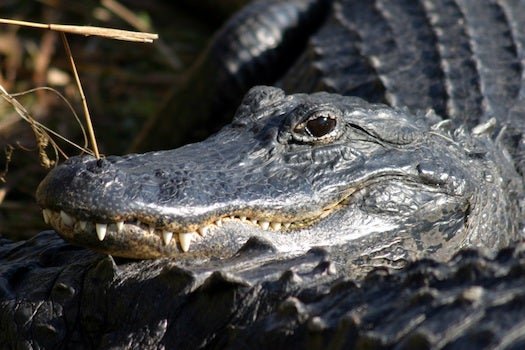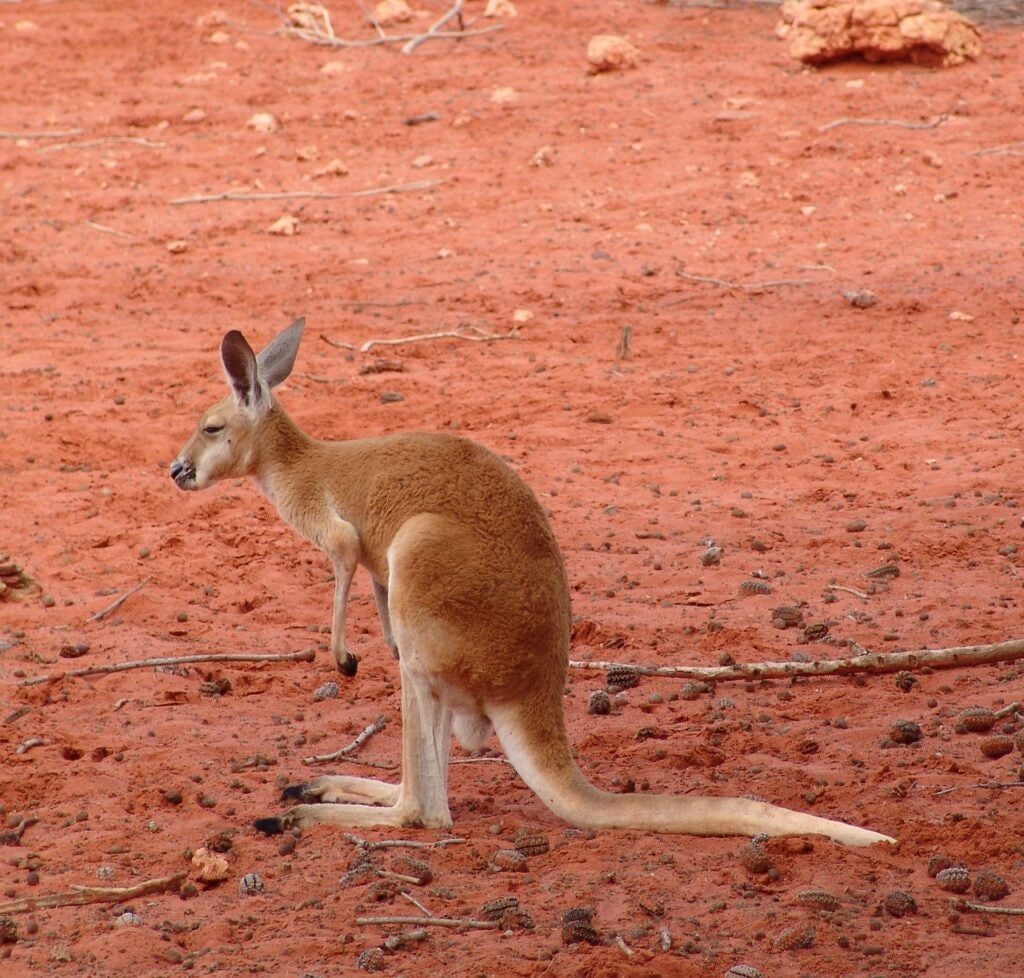What Animals Would Go Extinct Without National Parks
Final Th, the Trump administration announced a proposal to cut provisions in the Endangered Species Act (ESA)—the law that for almost half a century, has protected plants and animals at risk of extinction. The law has broad and bipartisan support across the land, with around 80 percent of Americans expressing their support for the law.
Announced jointly by the U.S. Fish and Wild animals Service and the National Oceanic and Atmospheric Administration—the two agencies that govern the ESA—the proposed changes aim to "improve collaboration, efficiency, and effectiveness," just those opposing the proposal contend that it may exit some plants and animals more than vulnerable.
For conservationists, ane of the nearly concerning changes is hitting out language that previously prevented economics from factoring in on decisions to protect species. As the act stands now, how to best preserve a vulnerable habitat is based purely on scientific data, not toll. Some worry that removing this rule could give businesses the go-alee to develop near protected habitats. In addition, the new proposal ways threatened species would no longer be extended the same protections as endangered ones—threatened species would be assessed on a case-by-instance ground.
"Species are literally of infinite value, they're priceless. Information technology shouldn't be a question of price," says Bob Dreher, senior vice president for conservation programs for the nonprofit arrangement Defenders of Wildlife, regarding the assart of economic consideration into the fate of a vulnerable plant or animal.
"Although a number of these regulatory changes may be fairly minor and may make sense, there's well-nigh nothing nosotros run across in this parcel that actually enhances protection of endangered species," he says. "And there are a number of provisions that may exit species exposed to threats. Information technology really isn't a package of regulations an administration that really cared about endangered species would be putting out."
Right now, the ESA protects more than one,600 plants and animals at take a chance of extinction, or at risk of becoming endangered. The act has been criticized in the past for delisting animals who all the same may be in demand of protection, but the deed has also helped more than 50 endangered or threatened species recover by protecting and restoring habitats, monitoring at-risk species, creating captive convenance programs, and reintroducing animals into the wild.
Here are 10 plants and animals the ESA has helped pull dorsum from the brink.
Bald eagle

These wide-winged birds of prey were plentiful in 1782 when the U.South. start adopted the beast as our national symbol. Just the bald hawkeye population plummeted after World War 2 when the highly toxic DDT pesticide was introduced. Birds were inadvertently ingesting DDT, weakening adults and causing them to produce feeble eggs. By 1963, just 417 breeding pairs were left in the lower 48 states.
The bald eagle was one of the first species protected nether the Endangered Species Preservation Act (a forerunner to today's ESA). In 1972, the Environmental Protection Agency banned Dichloro-diphenyl-trichloroethane. The ESA was officially in identify the following year, and the federal regulations protected nesting sites and helped repopulate the species through captive breeding programs. Bald eagles were taken off the listing of threatened and endangered species in 2007. At that place are at present almost ten,000 convenance pairs in the lower 48 states today.
Grizzy bear

It'due south hard to imagine a predator at the tiptop of the nutrient chain threatened by anything. But in 1975, grizzly bears living in the Greater Yellowstone Ecosystem—spanning parts of Wyoming, Montana, and Idaho—were listed as a threatened species.
Decades of logging, mining, and country development destroyed bears' habitats, and the corking creatures were oft hunted for sport or killed when spotted on human country. Past 1975, there were less than 200 bears left. Conservation efforts take brought the grizzly population in Yellowstone National Park back up to 700. Subsequently 42 years on the threatened species list, the bears were officially deemed recovered and delisted in 2017. But with no protections outside national parks, critics of the delisting have argued bears will exist susceptible to however dangers that cut downwardly their population in the outset place.
Greyness wolf

Similar grizzly bears, greyness wolves struggle to coexist with humans. At ane time, wolves were as common equally domestic dogs are today—sadly, these pack animals were always considered villains, not man'south best friend.
Although wolf attacks on humans were rare, the xanthous-eyed canines would option off unsuspecting livestock during the night, infuriating ranchers. Wolves were trapped, poisoned, or shot, hunted near to extinction. Past 1920, in that location were less than 40 left, and only a few packs persisted in Minnesota and on Isle Royale in Michigan. The species didn't receive protection until the ESA was enacted in 1973.
By the '90s, the U.Due south. Fish and Wildlife Service had brought wolves in from Canada to begin reintroduction. Wolves were delisted in 2008, just a surge of wolf shootings in the Rocky Mountains just ii months after resulted in a federal lawsuit to put wolves dorsum under the deed'south protection. The courts ruled in favor of the wolves, and by fall of 2008, they were back on the list of endangered and threatened species. In 2017, the wolf population was considered recovered, and delisted for the second time.
Humpback whale

Known for their melodic whale songs and beautiful breaches, the openness of these jumbo creatures may take led to their demise. Considering of their massive size and tendency to lounge near the surface of the water, humpback whales were easy prey.
The commercial whaling business almost wiped out these sea creatures completely, leaving just a few thousand alive worldwide. In 1966, hunting humpback whales was banned, and a few years later, the species was listed as endangered under the Endangered Species Conservation Act, some other police that preceded the ESA. Humpback whales were delisted in 2016, and effectually 20,000 are singing nether the sea today.
Eggert's sunflower

When we call up of endangered species, it'southward easy to focus on all the beloved animals that roam the earth. But there are many wild plants at risk, also. In 1997, Helianthus eggertii—a bright, yellow flowering plant indigenous to Tennessee, Alabama, and South Carolina—was listed every bit a threatened species.
What jeopardized this tall flower's survival is also a threat to human habitat: wildfire. Considering these plants abound in such barren environments, they rely on wildfires to propagate. Merely of form, raging outbursts of flame are no skilful for humans, and fire suppression efforts fabricated it difficult for these already rare plants to persevere. Put nether the ESA's protection in 1997, the species was able to recover through restorative burns in secured areas. Now 287 populations of the rare sunflower exist, and the institute was listed as recovered in 2005.
American alligator

Toothy
Alligators managed to survive and thrive for millions of years—until humans came along. Like wolves and whales, alligators were virtually hunted to extinction. Found in the swampy, southern states, the alligator population was almost decimated due to unregulated hunting. In 1967, alligators were listed as an endangered species, and alligator hunting was prohibited under the newly formed ESA in 1973.
Xx years afterwards, the alligator recovered, making one of the human activity'due south quickest comebacks. Now a species of to the lowest degree concern (there are effectually five million gators in the U.Southward. today), alligator hunting has been fabricated legal again.
Tennessee purple coneflower

This hitting daisy-like flower was the 2d plant (post-obit the evening primrose) to be put on the endangered species list in 1979. It only existed in 1 place in the world: a fourteen-mile stretch of limestone cedar glade (as well an endangered ecosystem) near Nashville, TN. Ripe with aromatic red cedar trees growing atop a bed of limestone, this otherworldly area is full of fissures where the purple coneflower grows. As Nashville developed, the species and its habitat became threatened. A conservation plan was implemented, and through protections of the ESA, the establish was recovered in 2011. This plant is now plentiful, and you can even purchase seeds and try growing it yourself.
Peregrine falcon

The story of the fastest bird in the world parallels the i of the bald eagle. Falcon numbers were already on the decline due to loss of habitat, hunting, and egg collecting, just it was the pesticide Dichloro-diphenyl-trichloroethane that really did in these kings of the air. By the '60s, no peregrine falcons existed in the eastern U.S., and in 1970, the species was listed as endangered.
Protected under the ESA, the birds were successfully bred in captivity and reintroduced into the wild. The peregrine falcon was delisted in 1999, and at that place are effectually 3,000 breeding pairs in North America today.
Red kangaroo

Australia Blood-red Kangaroo Large
Information technology'due south non just animals on American soil the ESA has helped recover. Found in Australia, the red kangaroo is sought subsequently for its meat and hide. Now, the mammoth marsupials are and then plentiful that kangaroo hunting in Australia is considered sustainable. Merely in 1974, excessive hunting put the them on the endangered species list. Shortly after, the ESA aided conservationists overseas by putting a ban on all imports of kangaroos or kangaroo-derived products. The species moved from threatened to recovered, and was delisted in 1995.
Virginia flight squirrel

It seems similar squirrels are ever just a rock's (or perhaps peanut) throw away, but those that fly through the air at night are rare. There in one case was no shortage of coniferous tree tops in the Appalachian Mountains to glide between, merely deforestation speedily pushed the squirrel species to near extinction.
Put on the endangered list in 1985, the flying squirrels were thought to have recovered in 2008, but were put back nether protection in 2011. In the months after its reinstatement, conservation efforts made to regenerate forests led to a restoration of the species, and by 2013, the flight squirrel was officially declared recovered.
Source: https://www.popsci.com/endangered-species-act-recovered/
Posted by: reyesfewillic.blogspot.com

0 Response to "What Animals Would Go Extinct Without National Parks"
Post a Comment